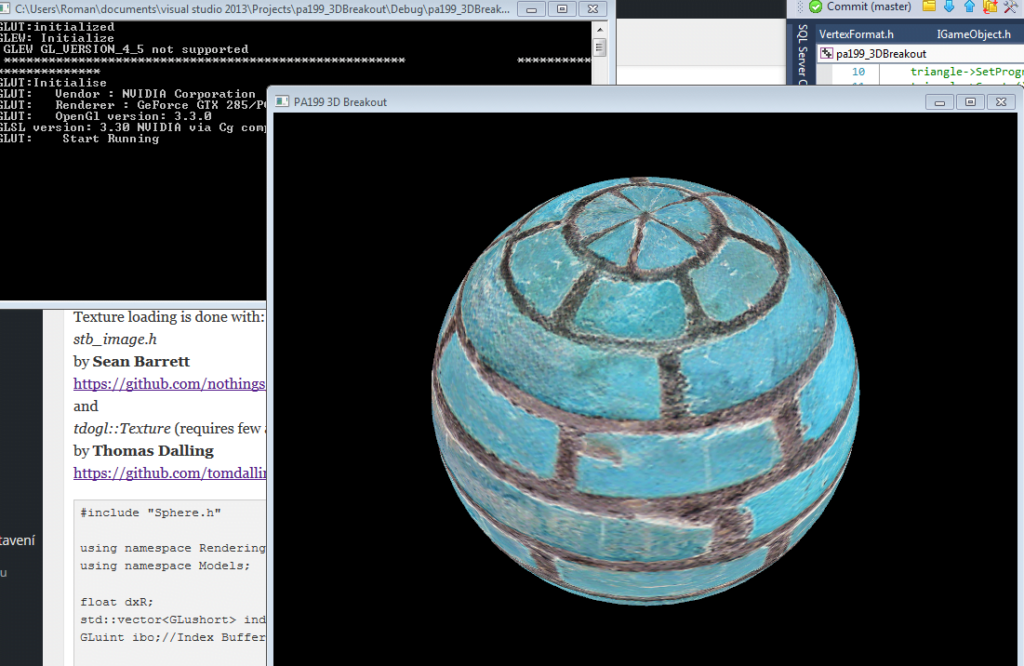Rewritten code from http://stackoverflow.com/questions/5988686/creating-a-3d-sphere-in-opengl-using-visual-c/5989676#5989676
Texture loading is done with:
stb_image.h
by Sean Barrett
https://github.com/nothings/stb
and
tdogl::Texture (requires few additional tdogl headers)
by Thomas Dalling
https://github.com/tomdalling/opengl-series
#include "Sphere.h"
using namespace Rendering;
using namespace Models;
float dxR;
std::vector<GLushort> indices;
GLuint ibo;//Index Buffer Object for indices
Sphere::Sphere()
{
dxR = 0.0f;
}
Sphere::~Sphere()
{}
void Sphere::Create()
{
GLuint vao;
GLuint vbo;
tdogl::Bitmap bmp = tdogl::Bitmap::bitmapFromFile("Textures/ball.png");
gTexture = new tdogl::Texture(bmp);
glGenVertexArrays(1, &vao);
glBindVertexArray(vao);
std::vector<VertexFormat> vertices;
glm::vec4 blue = glm::vec4(0, 0, 1, 1);
int n = 1;
unsigned int rings = 24*n;
unsigned int sectors = 48*n;
float const R = 1.0f / (float)(rings - 1);
float const S = 1.0f / (float)(sectors - 1);
float pi = 3.14159265358979323846f;
for (unsigned int r = 0; r < rings; r++) {
for (unsigned int s = 0; s < sectors; s++) {
float const y = sin(-pi / 2.0f + pi * r * R);
float const x = cos(2 * pi * s * S) * sin(pi * r * R);
float const z = sin(2 * pi * s * S) * sin(pi * r * R);
glm::vec2 texCoord = glm::vec2(s*S, r*R);
glm::vec3 vxs = glm::vec3(x, y, z);
vertices.push_back(VertexFormat(vxs, blue, texCoord));
}
}
indices.resize(rings * sectors * 6);
std::vector<GLushort>::iterator i = indices.begin();
for (unsigned int r = 0; r < rings - 1; r++) {
for (unsigned int s = 0; s < sectors - 1; s++) {
*i++ = r * sectors + s;
*i++ = r * sectors + (s + 1);
*i++ = (r + 1) * sectors + (s + 1);
*i++ = (r + 1) * sectors + (s + 1);
*i++ = (r + 1) * sectors + s;
*i++ = r * sectors + s;
}
}
verticesSize = vertices.size();
glGenBuffers(1, &vbo);
glBindBuffer(GL_ARRAY_BUFFER, vbo);
glBufferData(GL_ARRAY_BUFFER, sizeof(VertexFormat) * verticesSize, &vertices[0], GL_STATIC_DRAW);
glGenBuffers(1, &ibo);
glBindBuffer(GL_ELEMENT_ARRAY_BUFFER, ibo);
glBufferData(GL_ELEMENT_ARRAY_BUFFER, sizeof(GLushort) * indices.size(), &indices[0], GL_STATIC_DRAW);
glBindBuffer(GL_ELEMENT_ARRAY_BUFFER, 0);
glEnableVertexAttribArray(0);
glVertexAttribPointer(0, 3, GL_FLOAT, GL_FALSE, sizeof(VertexFormat), (void*)0);
glEnableVertexAttribArray(1);
glVertexAttribPointer(1, 4, GL_FLOAT, GL_FALSE, sizeof(VertexFormat), (void*)(offsetof(VertexFormat, VertexFormat::color)));
glEnableVertexAttribArray(2);
glVertexAttribPointer(2, 2, GL_FLOAT, GL_TRUE, sizeof(VertexFormat), (void*)(offsetof(VertexFormat, VertexFormat::texture)));
glBindVertexArray(0);
this->vao = vao;
this->vbos.push_back(vbo);
}
void Sphere::Update()
{
dxR += 1.0f;
if (dxR > 360.0f)
dxR = 0.0f;
}
void Sphere::Draw()
{
glUseProgram(program);
GLuint camera = glGetUniformLocation(program, "camera");
GLuint projection = glGetUniformLocation(program, "projection");
GLuint model = glGetUniformLocation(program, "model");
GLuint texture2d = glGetUniformLocation(program, "tex");
glm::vec3 topView = glm::vec3(0, 4, 0.1);
glm::vec3 perspectiveView = glm::vec3(0, 3, 3);
glm::vec3 selectedView = perspectiveView;
//eye - position of the camera's viewpoint,
//center - where are you looking, up = up is Y+
glm::mat4 cameraMatrix = glm::lookAt(selectedView,
glm::vec3(0, 0, 0),
glm::vec3(0, 1, 0));
glm::mat4 identityMx = glm::mat4(glm::vec4(-1, 0, 0, 0),
glm::vec4(0, 1, 0, 0),
glm::vec4(0, 0, 1, 0),
glm::vec4(0, 0, 0, 1));
glm::mat4 rotated = glm::rotate(identityMx, glm::radians(dxR), glm::vec3(0.0f, 1.0f, 0.0f));
glUniformMatrix4fv(camera, 1, GL_FALSE, glm::value_ptr(cameraMatrix));
glUniformMatrix4fv(projection, 1, GL_FALSE, glm::value_ptr(projectionMatrix));
glUniformMatrix4fv(model, 1, GL_FALSE, glm::value_ptr(rotated));
glActiveTexture(GL_TEXTURE0);
glBindTexture(GL_TEXTURE_2D, gTexture->object());
glUniform1i(texture2d, 0);
glBindVertexArray(vao);
glDrawElements(GL_TRIANGLES, indices.size(), GL_UNSIGNED_SHORT, &indices[0]);
}
#pragma once
#include "Model.h"
#include <glm/glm.hpp>
#include <glm/gtc/type_ptr.hpp>
#include <glm/gtc/matrix_transform.hpp>
#include <cmath>
namespace Rendering
{
namespace Models
{
class Sphere : public Models::Model
{
public:
Sphere();
~Sphere();
void Create();
virtual void Draw() override final;
virtual void Update() override final;
};
}
}
Sphere class inherits from Models class. It is partly rewritten from tutorial http://in2gpu.com/opengl-3/.
#pragma once
#include <vector>
#include "../IGameObject.h"
#include <glm/glm.hpp>
#include <glm/gtc/type_ptr.hpp>
#include <glm/gtc/matrix_transform.hpp>
#include "../tdogl/Texture.h"
namespace Rendering
{
namespace Models //create another namespace
{
class Model :public IGameObject
{
public:
Model();
virtual ~Model();
// methods from interface
virtual void Draw() override;
virtual void Update() override;
virtual void SetProgram(GLuint shaderName) override;
virtual void Destroy() override;
virtual GLuint GetVao() const override;
virtual const std::vector<GLuint>& GetVbos() const override;
protected:
GLuint vao;
GLuint program;
std::vector<GLuint> vbos;
unsigned int verticesSize;
tdogl::Texture* gTexture;
static glm::mat4 projectionMatrix;
};
}
}
#include "Model.h"
using namespace Rendering;
using namespace Models;
glm::mat4 Model::projectionMatrix = glm::perspective(glm::radians(35.0f),
800.0f / 600.0f,
0.1f, 10.0f);
Model::Model()
{
verticesSize = 0;
gTexture = NULL;
}
Model::~Model()
{
Destroy();
}
void Model::Draw()
{
//this will be again overridden
}
void Model::Update()
{
//this will be again overridden
}
void Model::SetProgram(GLuint program)
{
this->program = program;
}
GLuint Model::GetVao() const
{
return vao;
}
const std::vector<GLuint>& Model::GetVbos() const
{
return vbos;
}
void Model::Destroy()
{
glDeleteVertexArrays(1, &vao);
glDeleteBuffers(vbos.size(), &vbos[0]);
vbos.clear();
}
And IGameObject is…
#pragma once
#include <vector>
#include <iostream>
#include "..\..\packages\nupengl.core.0.0.0.1\build\native\include\GL\glew.h"
#include "..\..\packages\nupengl.core.0.0.0.1\build\native\include\GL\freeglut.h"
#include "VertexFormat.h"
namespace Rendering
{
class IGameObject
{
public:
virtual ~IGameObject() = 0;
virtual void Draw() = 0;
virtual void Update() = 0;
virtual void SetProgram(GLuint shaderName) = 0;
virtual void Destroy() = 0;
virtual GLuint GetVao() const = 0;
virtual const std::vector<GLuint>& GetVbos() const = 0;
};
inline IGameObject::~IGameObject()
{//blank
}
}
VertexFormat is defined as:
#pragma once
#include "glm\glm.hpp" //installed with NuGet
namespace Rendering
{
struct VertexFormat
{
glm::vec3 position;
glm::vec4 color;
glm::vec2 texture;
VertexFormat(const glm::vec3 &iPos, const glm::vec4 &iColor, const glm::vec2 &iTex)
{
position = iPos;
color = iColor;
texture = iTex;
}
};
}
Result
I’ve used this sphere in PA199 3D Breakout (C++/OpenGL) project.


Leave a Reply